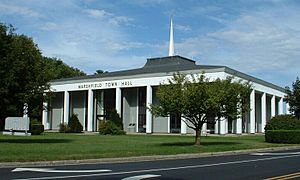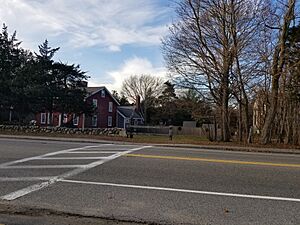History of Marshfield, Massachusetts facts for kids
Marshfield is a town located on the coast of Massachusetts, known for its beautiful beaches and rich history. It's about 30 miles (48 km) southeast of Boston. The town gets its name from the many salt marshes found along its three rivers: the Green Harbor River, the South River, and the North River.
Contents
A Look Back: Marshfield's History
Early Native American Life
Long before European settlers arrived, Native Americans lived in the Marshfield area for thousands of years. These included people from the Wampanoag and Massachusetts Tribes. There's evidence that people lived here as far back as 9,000 to 10,000 B.C.!
The Native Americans had already created well-used roads throughout the town. Many of these ancient paths are still used today as Marshfield's main roads. The Wampanoag name for this area was "Missacautucket."
Early English settlers and the Wampanoag people formed a strong friendship, especially between Chief Massasoit and Edward Winslow. This alliance lasted for 40 years. However, after Massasoit's death, tensions grew, leading to a conflict known as King Philip's War. While nearby towns were attacked, Marshfield was fortunate and was not harmed during this war.
The Pilgrims Arrive
Marshfield is one of the oldest Pilgrim towns, first settled as part of the "New Colony of New Plimoth in New England" which began in 1620.
In 1632, Edward Winslow, a Pilgrim who sailed on the Mayflower and later became a governor of Plymouth Colony, established Marshfield as a separate settlement. He was a key figure in the colony, helping to negotiate with Native Americans and with England. Edward Winslow also started the town's first church and school. He wrote several important books about Plymouth Colony, which help us understand what life was like back then.
Winslow also played a big role in bringing cattle to the colony, which helped farming become a major industry in Marshfield for many years. The area was first called "Green's Harbor" and then "Rexhame" before finally being named "Marshfield" because of its many salt marshes. The town officially became separate from Plymouth Plantation in 1640.
Peregrine White: New England's First English Baby
One famous early resident of Marshfield was Peregrine White. He was the very first English child born in New England! Peregrine was born on November 20, 1620, on the Mayflower ship while it was anchored near Provincetown.
His mother, Susanna White, later married Edward Winslow after both of their first spouses passed away during the difficult first winter. Susanna was also the first English bride and the first English woman to give birth in New England.
Peregrine grew up in Marshfield on a large piece of land granted to Edward Winslow. He became a successful farmer, known for planting many European fruit trees. He also served in various town roles, including as a selectman and a lieutenant in the local militia. Peregrine lived to be 84 years old.
You can still see Peregrine White's baby cradle, which is believed to be the first cradle used for an English baby born in New England, on display at Pilgrim Hall in nearby Plymouth.
Land and the Seashore
To ensure peaceful settlement, an early leader named Josiah Winslow got a deed for the town from Chief Chickatawbut of the Massachusett Tribe. This agreement allowed English settlers to live there, but it also said that members of the Massachusett Tribe could always hunt and fish in the area.
Marshfield also had a lot of "common land," which means it wasn't owned by any one person. Even today, some of this common land remains, like the town's beautiful five-mile (8 km) long seashore along the Atlantic Ocean. The courts have ruled that Marshfield's seashore, including its sandy beaches and dunes, is a public place for everyone to use.
Marshfield During the American Revolution
A Town Divided: Loyalists and Patriots
During the time of the American Revolution, Marshfield was known as a strong center for Loyalists. Loyalists were people who wanted to remain loyal to the King of England, while Patriots wanted independence. Marshfield was unique because Loyalists had a lot of control in the town, unlike in many other Massachusetts towns where Patriots were stronger.
Many of Marshfield's families had lived there for generations and were connected to powerful figures in the British government. Some even sent their sons to Harvard College. These families often believed that problems with Britain could be solved through talking and diplomacy, rather than through a violent rebellion. They saw themselves as English subjects of the King.
In 1774, a large group of Patriots from nearby towns planned to march to the home of Nathaniel Ray Thomas, a prominent Loyalist in Marshfield, to demand he resign from his government position. However, Thomas was warned and escaped to Boston, which was controlled by the British. For Marshfield, this event showed that the Revolution was already beginning.
The Associated Loyalists
In December 1774, many Marshfield residents formed a Loyalist group called the "Associated Loyalists of Marshfield." This group had hundreds of members, possibly most of the adult men in town. They pledged to oppose any colonial congresses, stay loyal to the King, and defend their beliefs. They held their meetings at the historic 1699 Winslow House.
At this time, all three of Marshfield's town leaders (Selectmen) were Loyalists. Patriots from other towns tried to force Marshfield Loyalists to change their minds, even kidnapping some and making them sign statements against their beliefs.
In January 1775, the Associated Loyalists of Marshfield asked General Gage, the commander of British troops in Boston, to send soldiers and weapons to Marshfield to protect them.
British Troops Arrive
To help the Loyalists, General Gage sent 114 British troops to Marshfield on January 23, 1775. They arrived on two armed ships and marched into the town without any problems. The soldiers stayed in the homes of Loyalists, including Nathaniel Ray Thomas's large estate. They were there to keep order and protect the Loyalists.
A letter from a Marshfield Loyalist, published in a New York newspaper, said that the British troops were "joyfully received" and that Loyalists could now "freely utter his thoughts, drink his tea and kill his sheep, as profusely as he pleases."
On February 20, 1775, Marshfield's Town Meeting voted to reject the authority of the Patriot's Provincial Congress and sent thank you letters to General Gage and Admiral Graves for sending the troops.
The British Leave Marshfield
The day after the first battles of the Revolution at Lexington and Concord on April 19, 1775, about a thousand Patriot militia members from surrounding towns marched into Marshfield. They planned to attack the British soldiers and the Loyalists who were hosting them.
However, the British ships arrived just in time to evacuate the troops and over one hundred Loyalists from Marshfield to Boston. The British ships landed near Brant Rock. Marshfield Loyalists helped alert the British troops to the ships' arrival by firing guns from a place called "Signal Hill." Some Marshfield Loyalists joined British regiments in Boston, while others were captured by the Patriot militia. The weapons sent by General Gage for the Loyalists were taken by the Patriots.
Marshfield Loyalists in the War
During the war, many Marshfield residents fought for the British. Edward Winslow, Jr., a descendant of Pilgrim Governor Edward Winslow, became a leader of Loyalist regiments. Pelham Winslow, a Marshfield native and brother of Dr. Isaac Winslow, became a Major with the British forces.
Abijah White, a descendant of Pilgrim Peregrine White and a town leader in 1774, was wounded while fighting alongside British forces in a naval battle near Boston Light in July 1775. He died not long after.
In July 1775, General George Washington, who was leading the Patriot forces, ordered the first arrest of a Loyalist in the American Revolution at the Kenelm Winslow house in Marshfield.
The Loyalists Leave Marshfield
After the British left Boston in March 1776, many Marshfield Loyalists were forced to leave Massachusetts. They faced angry mobs, arrests, and their land was taken away. Many of them fled to places like New Brunswick, Nova Scotia, and other parts of Canada and Maine. Most of the people who left Plymouth County during this time were from Marshfield. This loss of so many residents and businesses greatly changed Marshfield.
The Marshfield Tea Party
Even though many people in Marshfield were Loyalists, there were also strong Patriots. Marshfield had its own version of the famous Boston Tea Party! On December 19, 1773, Marshfield Patriots took tea from a local tavern (which is now The Corner Cafe). They then knelt in prayer and burned the tea on a large rock on "Tea Rock Hill" as a protest against the British government.
Finally, on June 19, 1776, Marshfield's Town Meeting voted to support independence from Britain, just fifteen days before the national Declaration of Independence.
Marshfield's unique Loyalist history has shaped its traditions. For many years, the town's July 4th celebrations were much quieter than those in surrounding towns, and sometimes there were no celebrations at all. The Marshfield Tea Party is one of the few symbols of its Revolutionary past that the town highlights, showing its complex history.
Marshfield Today
In its early days, Marshfield's main industries were farming, raising cattle, fishing, and harvesting salt marsh hay. Sadly, some early families in the town, including the Winslow family, held people as slaves. Some of the old stone walls you see along fields and roads in Marshfield were likely built by enslaved people.
Later, shipbuilding became important, with over 1,000 ships built along the North River in the 1800s. Marshfield is also famous as the place where Reginald Fessenden sent the first transatlantic voice radio broadcast from Brant Rock in 1907.
In 1941, a huge fire destroyed about 400 buildings in the eastern part of town in just three hours. This was one of the largest fires in U.S. history in terms of structures lost.
Today, Marshfield is a mix of rural and suburban areas. Many residents commute to Boston for work. Some old farms and historic houses still remain. The town is also a popular summer resort, with many visitors coming to enjoy its beautiful beaches. The Marshfield Fair, the oldest agricultural fair in the United States, is a highlight of the summer, celebrating the town's farming roots. The beach and sea remain a central and beautiful part of Marshfield's identity.



